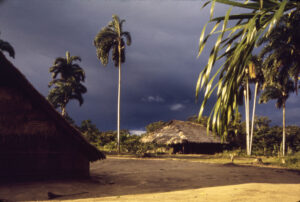
Back of longhouse and Jean Jackson’s house. Collection of Research Photography by Jean Jackson.
From 1968 to 1970, Jean E. Jackson, professor emerita of anthropology at MIT and Margaret MacVicar Faculty Fellow, conducted field research among Indigenous people of the Vaupés, Colombia. A collection of more than 600 photographs from Jackson’s fieldwork depict, in her words, “people and lifeways that have disappeared” and provide an important resource for anthropology researchers.
Jackson’s photographs depict isolated communities in the remote Amazonian tropical forests in southeast Colombia, on the border with Brazil. She focused her research there on the language exogamy system among Indigenous inhabitants known collectively as Tukanoans. Linguistic exogamy refers to a system that requires marriage outside of one’s patrilineal descent group; these groups are each associated with a distinct language. Jackson’s research on Tukanoan language identity continues to be used in courses today.
Starting in 2011, the MIT Libraries began a project to digitize Jackson’s photographs and make them available to researchers, with the Imaging Lab completing the initial scanning of the slides. Chris Donnelly, Image Cataloging and Technical Associate, worked closely with Jackson to describe and catalog the collection, as well as Digital Library Systems Manager Carl Jones to add them to Dome, the Libraries’ digital repository of images, media, maps, and more, in 2015.
Recently, Jackson sent her collection of books on Colombia and the Indigenous movement in Latin America to the library at the Universidad de los Andes in Bogotá. Recognizing that the images from her fieldwork in the Vaupés region could add great value to the collection, Jackson turned once again to Donnelly, who helped facilitate a transfer of the images and descriptions to the library.
“The digitized slides and accompanying information from my 1968-69 fieldwork are very valuable, because the world that these slides depict has vanished,” says Jackson. “I am extremely pleased with MIT Libraries’ decision to make them available to the Universidad de los Andes Library. Inter-library collaborations like this are to be encouraged and celebrated.”
One of the earliest members of MIT’s Anthropology program and a founding member of the Women’s and Gender Studies Program, Jackson retired in 2014 after 42 years at the Institute. She donated her papers, including course notes and correspondence, to the MIT Libraries’ Distinctive Collections in 1998. A selection of her articles is also available in the Open Access Collection of DSpace@MIT.

